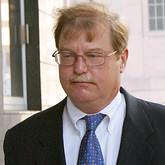 Does the end of convicting a business executive of a crime justify the means by which government prosecutors accomplish it?
Does the end of convicting a business executive of a crime justify the means by which government prosecutors accomplish it?
James Brown, the former Merrill Lynch executive and one of the defendants in the Enron-related criminal case known as the Nigerian Barge case, has to be asking himself that question as he continues to endure what is now his seventh year of prosecutorial hell.
Even in the littered landscape of failed Enron-related prosecutions, the Nigerian Barge prosecution stands out for its sheer brazen nature.
The Nigerian Barge prosecution was baseless from the start and, as later developments revealed, trumped-up to boot.
But as Brown’s Supplemental Memorandum below filed this past Friday explains, “trumped-up” is too kind a term to describe what the prosecutors did to Brown and his fellow Merrill co-defendants.
A quick history of the case is helpful. After prosecuting Arthur Andersen out of business in the intensely anti-business post-Enron climate of Houston in 2004, the Enron Task Force threatened to do the same to Merrill Lynch unless the firm served up some sacrificial lambs, which the firm did by offering up Brown and fellow Merrill executives Dan Bayly, Robert Furst, and William Fuhs.
Through a deferred prosecution agreement with Merrill, the Task Force hamstrung the Merrill defendants’ defense by limiting access to other Merrill Lynch executives who were involved in the barge transaction and who would have testified favorably for the defendants. To make matters worse, the Task Force then intimidated other potentially exculpatory witnesses by threatening to indict them if they cooperated with the Merrill defendants’ defense.
Thus, after bludgeoning a couple of plea deals from former Enron executives Ben Glisan and Michael Kopper, the Task Force proceeded to put on a paper-thin case against the Merrill defendants, which was good enough to obtain convictions in Houston’s deeply-hostile environment in 2005 toward anyone having anything to do with Enron.
Of course, most of the convictions were vacated on appeal (and in Fuhs’ case, thrown out completely). However, each of the Merrill defendants served over a year in prison during their appeal while their families endured the substantial human cost of this and other misguided Enron-related prosecution.
Even after the convictions of the Merrill defendants were vacated, the Department of Justice initially threatened to pursue a retrial of the three remaining Merrill executives. But then the DOJ recently dismissed all charges against Bayly, while Furst cut a favorable plea deal that will lead to a dismissal of the remaining charges against him.
So, logic dictates that the DOJ would dismiss its charges against Brown, the only remaining defendant. Right?
Well, not so fast.
The DOJ has inexplicably teed up another trial of Brown, who was the only one of the Merrill defendants who was convicted on additional charges of perjury and obstruction of justice for having the temerity of protesting his innocence to the grand jury that originally investigated the Nigerian Barge deal. Brown’s new trial is currently scheduled to begin on September 20.
But in the meantime, Brown’s legal team has been leafing through enormous amounts of exculpatory evidence that the Enron Task Force withheld from the Merrill defendants in connection with the first trial back in 2005, but which the DOJ has recently been forced to disclose.
The result of the Brown team’s effort is set forth below in the Supplemental Memorandum in support of a motion for a new trial for Brown on the perjury and obstruction charges (the downloaded version of the memo is bookmarked in Adobe Acrobat to facilitate ease of review). The memorandum details the appalling length that the Enron Task Force went during the first trial in suppressing exculpatory evidence in favor of Brown and his co-defendants and generally disregarding the rule of law in order to obtain convictions. As the memorandum concludes:
The conclusion is now inescapable that the ETF engaged in a calculated, multi-step process to deprive Brown of his constitutional right to Due Process. (1) They repeatedly denied the existence of Brady material, told this court they had met their Brady obligations and fought vehemently against producing anything [exhibit reference and footnote omitted]. They highlighted only selected material in a veritable garden of Brady evidence — much of their selections being vague, tangential or marginal — while working around clear, declarative, relevant exculpatory material even in the same page, paragraph or document. (3) When ordered by the Court to produce summaries to the defense, they further redacted even the Brady material they had themselves highlighted and withheld the crucial facts that they had highlighted as Brady. (4) They egregiously capitalized on their misconduct at trial by making assertions that were directly belied by the exculpatory evidence they withheld. . . .
The memorandum goes on to set out dozens of Brady violations, including charts that compare the exculpatory statements that the Enron Task Force withheld prior to the first trial with the incriminating statements that the Enron Task Force extracted from witnesses during that trial.
Folks, this is really bad stuff. But as bad as it is, I have not seen any mention of it in the mainstream media.
When is the mainstream media going to realize that the scandalous behavior of government prosecutors in prosecuting business executives in connection with the Enron case dwarfs the true crimes that were committed at Enron?
Or is the media’s stubborn refusal to challenge the Enron narrative an even bigger scandal than the prosecution’s misconduct?
James Brown Supplemental Memorandum in Support of Motion for a New Trial

Aw, man. I’m disappointed. I thought you’d have a cool video of the “hardest working man in show business” – but you meant the OTHER James Brown…
Oh, well, my audio is down anyhow…
jd